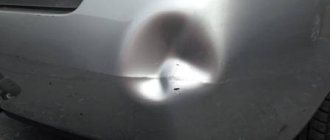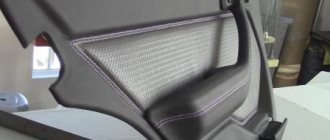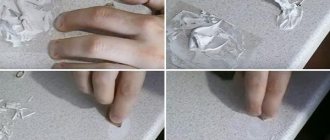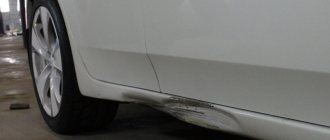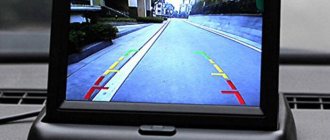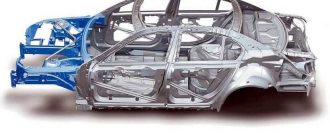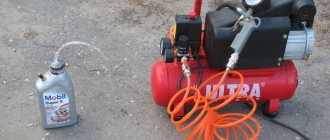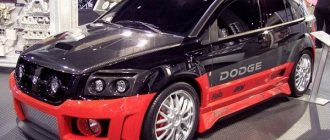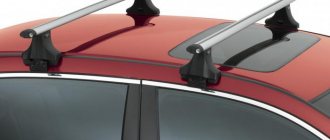It’s rare that a garage is used exclusively for storing a car, but even one over time acquires a bunch of home-made products necessary for its maintenance. Often it is the garage that serves as a home workshop for its owner. What should you fill it with to make the life of the car owner easier and, of course, save on car repairs and maintenance.
We will talk about homemade products for the garage and home craftsman that you can make with your own hands.
Interesting storage ideas
The very first thing, in my opinion, that needs to be created in the garage is a place to store all kinds of small items and tools. These can be racks or shelves that will fit well into the garage interior and help put things in order. They can be built from wooden boards or metal corners that you left over when renovating or building a house.
And with the help of magnets you can easily tidy up small parts.
A garage is very useful for storing garden supplies, if space allows, because... It is not always the case that a special room is allocated for such things in a suburban area. The photo below shows how easy it is to do this using strips and hooks.
It is also convenient to store travel and sports equipment in the garage (after all, not everyone in their city apartment has extra space to store bicycles for the winter).
The following devices on the ceiling save a lot of space in the room:
And most importantly, tires have a special place in the garage. Real home craftsmen can easily make tire holders with their own hands.
And if you have a welding machine, then such holders can be made from metal corners.
It saves space and keeps the garage clear of clutter. And you can safely create masterpieces in making homemade products for repairing and servicing your car.
How to make a two-jaw wheel bearing puller: video
Making a bearing puller with your own hands is not at all difficult - you don’t need either expensive materials or specific skills. Using the instructions, you will easily cope with the task and get a useful tool for car repair.
- Author: Dmitry BuimistrovPrint
Homemade wheel bearing puller: drawings, photos, videos of a homemade device.
The author decided to make a homemade version of a tool for pressing out wheel bearings, an analogue of the one sold in stores.
Steel plates with a thickness of 8 mm and a pipe with a wall thickness of 7 mm were found as materials for manufacturing.
Stands and mini-overpasses in the garage
A jack is a standard tool included with a car, but it is strictly prohibited to carry out even minor work under the bottom of the car when it is hung on a jack. And sometimes it is necessary to lift its entire front or back part.
In this case, you can’t do without goat stands.
Sometimes the stands are made in the form of mini-overpasses that the car runs over.
In addition to the general requirements listed below, an important element of such stands is the travel limiter at the front of the structure.
It doesn’t matter what they are made of, but the requirements are the same:
- stable wide support;
- safety margin for the design weight of the vehicle;
- minimal gaps between moving elements for height-adjustable stands.
The video shows the simplest coasters with a drive-in:
But in this case, we would recommend increasing the support base.
DIY bearing puller
Very often, just such a homemade product is not at hand in the garage during repairs that do not require the involvement of service specialists.
After all, they are used to remove not only bearings from the shafts, but also gears, and they will also help press out and press in silent blocks and so on.
A factory-made bearing puller is quite expensive, but making this device yourself is not so difficult:
Even if you don’t have welding, and you need a puller urgently, you can clamp an elongated nut with stops between the strips of the puller body from the video. Or use a design with a powerful plate with drilled holes, as in the photo, where the nuts can simply work against the stop and without welding. But it’s also useful to have a small welder that can secure such elements in the garage.
Types of pullers
The auto tools market offers a wide selection of such removable mechanisms, which can be divided into two types:
- Screw;
- Lever.
Screw pullers are considered universal and are suitable for working with almost any car.
The force in them is created by screwing the bolt into the puller body. The housing itself is put on the support eye, and when tightened, the bolt rests against the support pin and presses it out of the socket.
Lever removable mechanisms are no less effective, but they are larger in size, so they may not be suitable for every car.
For example, with such a puller on a VAZ-2107 you can still remove the upper ball joint, but you won’t be able to get to the lower one due to very limited space.
For these purposes, a special puller is used.
The essence of a lever puller comes down to the presence of two levers connected in the middle.
On the one hand, holes are made in them and a coupling bolt is installed.
To press out, one lever is installed between the eye and the support, while the second lever is placed under the finger.
When the bolt is unscrewed, due to the existing connecting axis, the ends of the levers begin to converge and the pin is pushed out.
But it is not necessary to purchase a removable mechanism; it can easily be made at home from improvised materials.
Next, we’ll look at several types of ball joint and steering wheel pullers that you can make yourself.
Homemade welding from a microwave transformer for the garage
This is one of the most suitable transformers for conversion into a welding machine. The primary winding in it is standard, only the secondary is altered. Moreover, the wire can be used thinner than in the video offered to you, but preferably with a cross-section of 8 - 10 mm:
The number of turns simply increases. Transformers from low-power microwave ovens produce welds with a power of 0.5 kW, a current of about 250A and an output voltage of about 2V. They are capable of welding 2 sheets of steel with a thickness of 1-1.5 mm.
Compressor from an old refrigerator in the garage
Despite its apparent weakness, it is a fully functional unit. With its help, you can pump up the tires and, with a little modification, paint the car. It is no weaker than most car compressors powered by a cigarette lighter, but unlike them, it can operate for a much longer time.
The main problem with the direct use of this compressor is the presence of a thermostat in its connection diagram as part of the refrigeration unit. It should be disabled:
But installing a fine filter on the outlet hose of a car that catches oil droplets is ineffective; it is better to use more powerful filters with sedimentation tanks for this purpose. The starting relay should be used as standard. The compressor is powered by 220V, which makes it connected to the mains, but in a garage it is a very useful device.
To inflate the wheels, you should put a gun with a pressure valve and a pressure gauge on the outlet hose, because this little thing can create pressure up to 16 atm.
And if you plan to use such a compressor to carry out small painting jobs, then you cannot do without a receiver.
Its role can be played by any sealed container capable of withstanding a pressure of 4 - 7 atm, into which 2 threaded or comb fittings can be inserted. Installation of a pressure gauge in such a system is mandatory.
You can also use a car wheel or even a camera as a receiver. A more stationary version of such a receiver is shown in the video:
But you don’t have to spoil the disk, but make the system simpler.
The pumping hose is connected to the system through a spool, and on the outlet branch there is a mechanism for shutting off the air in the paint sprayer.
Of course, you can also use a homemade spray gun.
But in this case, a shut-off valve should be installed in front of it. But the wheel can also be inflated with a mechanical pump; with a small air flow, such pressure will be sufficient.
The simplest devices for recharging the battery
Having a full-fledged car charger is good, but sometimes it’s quite expensive, especially since cheaper devices can also perform its function. So, a laptop charger can handle a full charge of a car battery with a capacity of up to 75 ampere-hours.
Moreover, there is no need to make any alterations, but simply plug in a 12-volt 55-watt car lamp into the circuit and periodically monitor the battery charge level with a multimeter.
When the indicator reaches 13 - 13.5V, you should stop charging - the battery is fully charged. In addition, it is extremely important not to confuse the polarity. This use of the adapter does not harm it at all.
In general, without any modifications, chargers for 12-volt cordless power tools handle the recharging function quite well, and most of them also have LEDs indicating that the battery is fully charged.
An old computer power supply can also slightly recharge a dead battery to a level sufficient to start the car. It has an output voltage of 12V, and to fully charge it needs to be up to 14V, but minor modifications can provide this voltage.
Tire mounting and balancing - homemade products for the home craftsman
Creating devices for independent tire mounting and balancing in your garage is realistic, and will allow you to constantly save quite a lot of money. And you don’t need a lot of equipment for this:
- universal machine for tire mounting;
- balancing device.
Some craftsmen take apart the functional parts of a tire changing machine, but in a garage it is better to combine them, on the contrary.
You will need a paw with a lever for tearing the tire off the rim and a stationary stand with holes for mounting the rim and a central stop pin. Mounting the disk can be done in various ways, but since you most often have 1-2 cars for personal use, it makes sense to make the mounts for specific wheels. The easiest way would be to drill holes for the bolts locally. The number of levers for removing and installing a tire on a disk can be large, or you can get by with just one – double-sided.
Tags: homemade tool
Comments 23
There is also one like in the first photo, still left from the case...
it's simple. Thank you
You’re welcome, it’s interesting to see who did what themselves.
DEFINITELY BOOKMARKED!
You can’t go anywhere without a homemade tool!)
The first stray thing I have, I didn’t think they made it themselves
the stray thing is needed, just to remove the tips.
haven't tried it yet. But one of these days I will test the chassis with the steering wheel and restore it
Well, I couldn’t resist, sorry. At the beginning of “IN THE SHARE” it hurts your eyes. The phrase comes from the word “DAL”. Plus in your text “AWAY” is written together.
It's okay =) Besides, I see that you are not from Russia. Therefore, there are no complaints. But it’s still worth fixing the mistake.
I just don’t understand how the steering rod puller from an open-end wrench works
it is welded to the puller itself from below
I just don’t understand how the steering rod puller from an open-end wrench works
you put a piece of key on the rod, and a knob in the welded head, and turn it
I just don’t understand how the steering rod puller from an open-end wrench works
There is such a store-bought gadget, it essentially has a pipe, a groove is cut into the pipe, and a sponge is inserted on a hinge from a gas wrench. and a 1/2 square under the knob is welded on it. you throw it on and twist it, the knob lies along the steering rod. It’s very convenient to tighten, not like trying to do anything with a wrench.
Recommendations for arranging a garage
For comfortable operation of a room intended for car storage, you should adhere to certain recommendations:
- the tool must be as accessible as possible;
- storage spaces equipped with shelves/racks are much more convenient;
- workbenches, inspection pits, homemade machines and do-it-yourself garage accessories expand the capabilities of the car owner;
- the cellar allows you to save space;
- The productivity of work and minor repairs depends on the quality of lighting.
Organization of work space inside the garage
Depending on the dimensions of the building, the area occupied by equipment, fixtures, and communications should not be more than 10–20% of the size of the garage floor.
Equipment and materials
In addition to the standard set of tools, it is advisable for you to carry with you special devices and materials that you may need to work with your own hands at the site of a breakdown:
- spare parts - it is advisable to have small spare parts with you that may be needed during repairs. These can be bolts, nuts, gaskets, hoses and the like;
- spare parts and components: belts, fuel pump, fuses and other little things that may fail you along the way;
- spare tire - if you puncture a tire, only the spare tire will save you;
- cigarette lighter - it will come in handy if you need to charge the battery from another car;
- wool gloves - useful to avoid injuring your hands during hard work;
- clean, dry rags and rags - they are used to wipe hands or car components from dirt, dust and oil.
Storage areas, racks, workbenches
In 80% of cases, do-it-yourself garage fixtures are built to store accessories, tools, and vehicle equipment. It should be taken into account that the most bulky parts of the car are sets of winter/summer tires, depending on the season.
Tire storage rules
It is more convenient to store wheels on brackets of the following design:
- two triangular frames from a corner, connected by jumpers from any rolled metal;
- the triangles are attached to the wall, the wheels are installed perpendicular to the supporting structure, falling slightly between the jumpers.
Wheel storage brackets
This is the most economical option for storing tires in the off-season. The most popular among car enthusiasts are straight and corner workbenches. The lower space is usually filled with shelves or drawers; sharpening machines and a vice are located on the tabletop.
Homemade garage workbench
A folding workbench can be very convenient
Wood is a universal material for both workbenches and shelving
It’s easier to build a wooden workbench yourself, but it has a shorter lifespan than its rolled metal counterpart, which needs to be welded. If corners for shelves are not built into the load-bearing walls during construction, it is easier to make racks from rolled metal or lumber.
Puller type - WEDGE
The simplest puller is the so-called “wedge”. It does not belong to any type of removable mechanism, but at the same time it is a fairly effective device for pressing out.
To make it, you only need an angle grinder (“grinder”), you can also use a machine with an abrasive wheel.
The blank will be a metal plate the size of a matchbox.
First, it is necessary to give the workpiece a wedge shape, for which we grind the metal with a grinder or machine so that the profile of the plate looks like a triangle. Then, using the same “grinder”, we make a cut in the middle 2/3 of the length of the workpiece from the side of the apex of the triangle, that is, from the thin side of the wedge. The width of the cut should be slightly larger than the thickness of the support pin, that is, you should get a kind of bracket.
If desired, you can weld a metal rod to the bracket, which will make it easier to work with the wedge in the future.
Pressing out a finger with a wedge is very simple. It is installed in the gap between the eye and the support body. And then the wedge is simply driven in with a hammer, which leads to the finger popping out of the socket.
The disadvantage of the wedge is that the boot will be damaged during the pressing process. Therefore, the wedge can only be used when replacing supports or tips.
If the suspension and steering mechanism are being repaired, which does not involve replacing the ball elements, it is better not to use a wedge.
Inspection pit and cellar
A necessary accessory for a DIY garage is an inspection hole. Moreover, the owner does not have to carry out all the repairs himself. Underground communications can be used in the following cases:
- inspection of the chassis, steering, and brake systems before a long trip;
- oil change, which allows you to save money and does not take much time;
- minor repairs that can be carried out by the owner's qualifications.
Inspection hole in the garage
It is more convenient to make the entrance to the cellar from a hole, as this will allow you to concrete several steps instead of using an extension ladder.
Cellar under the garage
The main nuances of these designs are:
- swelling of clay soils is harmful to underground structures;
- therefore, all elements of the pit and cellar are insulated from the outside with expanded polystyrene;
- sand or crushed stone is used in the underlying layer before concreting and backfilling of the pit sinuses;
- Drains are laid along the perimeter of underground structures at the base level to collect and drain water.
The width of the pit should allow the driver to enter it without lighting.
Lighting and ventilation
In garages, parallel circuits of lighting fixtures are more often used. One lamp allows you to use a specific area, several devices are turned on during a major renovation or a visit to the cellar. Minimum energy consumption is ensured by LED lamps. Daylighting devices have a great resource.
Cars use toxic, harmful fuels and lubricants, so do-it-yourself garage ventilation devices that allow you to create air exchange are becoming relevant. The influx is organized from below:
- garage - vents in the masonry, protected by bars;
- cellar - pipe from the garage or from the street.
Ventilation of the garage and cellar underneath
The hood is mounted under the ceiling of the cellar, the roof of the garage, or has the form of vents in the main walls at the highest points.
Related article:
Ventilation in the garage with your own hands. From this publication you will learn why garage ventilation is so important, what air exchange schemes exist, and installation nuances.
Other useful ideas
Useful accessories for the garage with your own hands can be made from used dishes, equipment, and materials left over from construction. For example, by gluing the lids of plastic cans horizontally/vertically, the owner receives convenient transparent containers for equipment or hardware, which are always at hand.
Device for storing small parts, tools, hardware
Interesting rack for storing screwdrivers made of PVC pipe
Homemade machines
From power tools you can assemble homemade machines and accessories for the garage:
- drilling - a drill fixed with clamps in a device that moves with a gear along a rack;
Drilling machine from a drill
- cutting - an angle grinder clamped in a similar way with equipment for metal or wood;
Angle grinder cutting machine
- wood lathe - the front headstock is made of a drill, the back headstock is made of a chuck, mounted on a frame made of a square pipe.
Drill lathe
The advantage of the machines is more accurate positioning of the equipment relative to the workpiece. The equipment turns out to be dismountable, the drill and angle grinder can be removed and used for their intended purpose.
Related article:
Metal lathe for the garage. Types of machines, technical characteristics, design, review of popular models in a special publication in our online magazine.
Hydropress
The simplest design of a hydraulic press is obtained from a car hydraulic jack. To press out/press in bearings and press/compress parts, you will need to build a frame and a removable movable stop. The frame consists of 4 channels welded to each other. At the top, the structure is reinforced with stiffening ribs (kerchiefs), and at the bottom, transverse corners are added, giving the frame stability.
Do-it-yourself hydraulic press from a jack
The stop is pulled in the normal position to the top crossbar of the frame by powerful springs. A hydraulic jack is installed between them, pressing the stop against the lower crossbar of the frame as necessary. The press force is regulated by a jack, the dimensions of the working area are selected depending on the size of the workpieces.
And finally, a few more examples of useful things for the garage.
Shelving near the ceiling
Pockets for storing cutting discs from disposable plates
Device for convenient use of threads and ropes
PVC pipe scraps are an ideal material for creating convenient storage areas
Convenient pull-out racks for storing tools
Other interesting homemade products
A potbelly stove made from old discs.
Garage door padlocks are exposed to frost, snow, and ice, so they rust and fail. Protection in the form of an improvised canopy is cut out of a car inner tube. The piece is fixed above the lock with a bolt and nut.
A good means of protecting a padlock from being cut or hacked is made from a metal pipe with a diameter of 25–35 cm. Cut off a part 15–20 cm long and attach it to the door leaf around the lock with bolts and nuts. With such a device for a garage, the lock cannot be opened with a master key, knocked down, or cut with a grinder. Such a device can also be hung on garage hinges so that they are not damaged.
Potbelly stove made from car rims
You will need sheet metal, doors for the combustion chamber, disks, a square pipe, a smoke exhaust manifold, screws, and heat-resistant paint.
The cores are removed from the disks with a grinder or plasma cutter, then a petal-shaped attachment is mounted. The edges of the disks are smoothed so that no gaps arise when joining, holes are welded in them and welded together.
The front and back walls are cut off and welded with thick sheet iron. Reliable legs for the stove are made from profile pipe. The fire door is installed in the hole with screws. A thick metal hob is installed on top of the structure.
They make a hole in the body for the chimney, weld it, and take it outside the garage. You can cook the grates yourself or buy them ready-made. The blower is made in the lower area of the stove, and a damper is installed.
